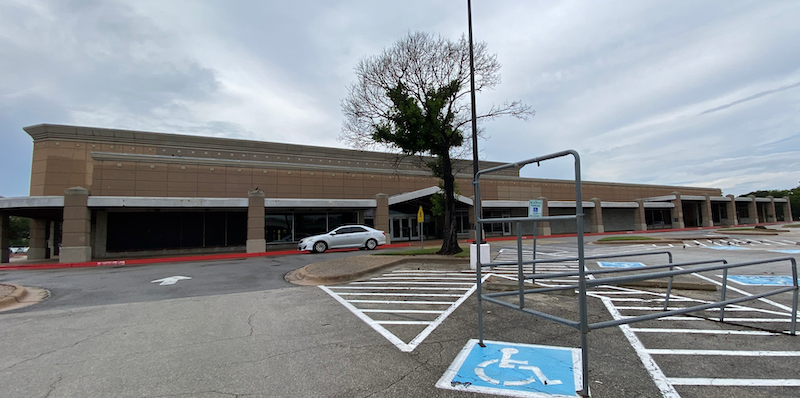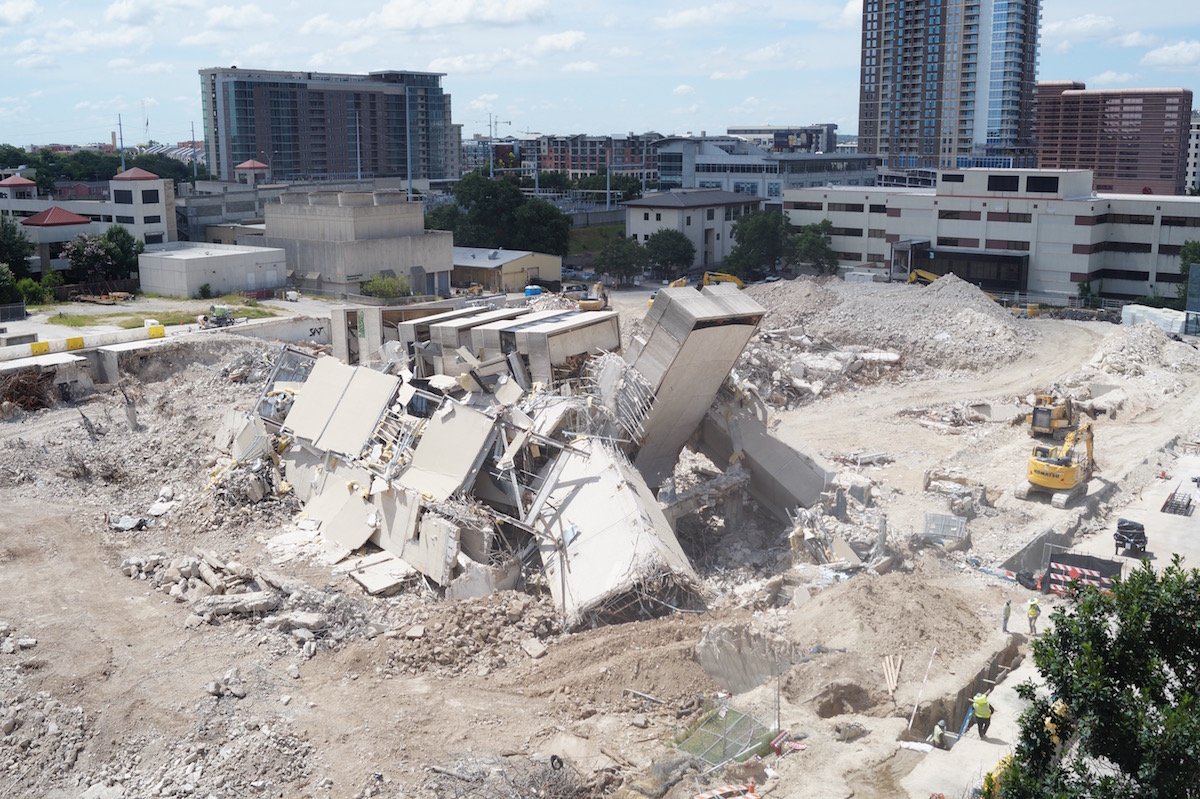
Agency also proposes 6 percent tax hike, despite projected $311 million surplus

Central Health is looking to acquire a former Sears department store as a new headquarters, a move that it says will save taxpayers money in the long term by consolidating existing administrative spaces.
But the immediate impact of the plan will be a higher tax bill, and the cost savings of the consolidation won’t be realized for more than a decade, according to a breakeven analysis presented at a recent board meeting.
Central Health, also known by its legal name, the Travis County Healthcare District, is a public hospital district governed by an appointed board of managers under the oversight of the county commissioners court. Its primary purpose is to pay for indigent healthcare services.

The board voted June 14 to approve a $62.6 million capital budget to acquire and renovate the former Sears building on the eastern edge of the Hancock shopping center at 43rd and Red River Streets, in addition to a nearby building currently occupied by one of Central Health’s subsidiaries, CommUnityCare. The buildings and adjacent parking lot abut the southbound frontage road of I-35.
Central Health already owns real estate worth more than $150 million, according to its 2020 annual report—a number that probably lowballs the actual market value of its properties. It’s also sitting on a contingency reserve of $227 million, which is projected to grow to $311 million next year.
Yet Central Health doesn’t plan to dip into its reserves or divest any of its existing assets to pay for the new headquarters. Instead, it plans to continue redeveloping the crown jewel in its property portfolio, a 14-acre campus that was once home to Brackenridge Hospital. The goal is to grow existing lease income from the campus to help fund its operating costs.
In the meantime, it will dip into the bond market to borrow $62.6 million for the new headquarters, plus $15.2 million for two new clinics in eastern Travis County. According to a public notice, the Travis County Commissioners Court will vote August 10th to authorize issuing the debt.
Spacious headquarters

Central Health plans to close on the Sears building by July 15. “We’re currently in a due diligence period and hope to complete the transaction,” said Chief Financial Officer Jeff Knodel at a June 14th board meeting.
Knodel presented a capital budget with an $18.8 million price tag for the property acquisition, plus $32.4 million for construction and renovation and a $5.8 million contingency for possible cost overruns on the project. Also included are $46,700 for due diligence and project assessment, $2.35 million for professional services, $44,500 for community engagement, and $2.5 million for furniture, fixtures and equipment.
The renovation would remake the drab, windowless exterior of the Sears building into a more attractive, glass-sided office building. It would also add a breezeway to connect the Sears building to the existing CommUnityCare clinic, a few parking spaces away.
Construction would start in December 2023 and wrap up in March 2024.
The new headquarters actually offers substantially more space than Central Health needs for its administrative workforce. More than half of the acquired space, 106,000 square feet, would be reserved for clinical services, compared to 90,000 square feet for administration.
In all, that’s about the size of four football fields, not counting the end zones.
“It’s a very large building,” Knodel said as he briefed the board. “It looks even larger every time I go. It actually has three levels. There are two levels that you see and then there is a basement level.”
Central Health executives haven’t revealed details about what kind of clinical services they expect to put in the Sears building, but they described it as a potential “one-stop shop.” That’s in contrast to the current service model, which offers different services from different clinics.
Former board member criticizes plan

For Frank Rodriguez, a former Central Health board member, the cost, size, and location of the Sears building are all problematic. In an interview with the Bulldog, he questioned why so much new clinical space was needed when Central Health hasn’t revealed what those services will be.
“Clinical space to do what? What are you going to deliver out of that? Nobody knows. There have been no public hearings,” he said. “The future of healthcare is bringing healthcare to the people—not to consolidate, and of all places in Hyde Park, to bring people up there to get served.”
Rodriguez is the community organizer for Health for Travis County, an advocacy group that has previously raised questions about Central Health’s finances and transparency. He said he supports the plan to build new clinics in Del Valle and Hornsby Bend, but he doesn’t think Hyde Park is the right place to be adding clinical space for indigent care.
The plan also raises concerns that Central Health could close clinics in other parts of the county, Rodriguez said. Knodel hinted at that possibility when he suggested that clinical space at the Sears center would be “in lieu of” spaces leased elsewhere in the county.
‘Substantial savings’ claimed
Despite criticism of the plan, Central Health’s board approved the new headquarters with just one vote against. Board members and executives characterized the acquisition as a necessary and long overdue consolidation of leased office spaces.
“Transitioning from leases to ownership will result in substantial long-term savings,” Knodel said.

CEO Mike Geeslin said, “We’ll invest in healthcare for people with low income by controlling long-term administrative costs. It’s simple math. Over time, it’s less expensive to own than to rent, and stewardship of public dollars is part of our responsibility to taxpayers.”
Central Health does in fact already own its current headquarters, a 16,000-square-foot building on east Cesar Chavez. But two subsidiaries, CommUnityCare and Sendero Health Plans, each lease their offices.
Consolidating under one roof would allow Central Health to terminate about $1.8 million of leases annually. Each entity would also need less space overall because they could share common areas like a break room, reception, and board room, Knodel said.
Other advantages of the plan include “protection from lease-rate inflation,” favorable debt market conditions, and the investment benefit of owning a real estate asset that can appreciate in value, he added.

On the other hand, board secretary Cynthia Valadez opposed the Hancock project, saying she felt there hadn’t been adequate public notice and discussion of it. She also questioned why Central Health’s current headquarters wasn’t being sold to help pay for the project.
“I had assumed the sale of our current location was going to be somehow tied to this,” she said.

Board Chair Sherri Greenberg replied that the issue simply hadn’t been decided yet, to which Valadez responded, “I think that’s something we need to determine quickly.”
In any case, Central Health would still need its current building for another few years until the renovation of the Sears building is complete. If it does decide to sell its headquarters, it could potentially use those proceeds to pay down the debt that it’s planning to start issuing in August, but it would be under no obligation to do so. The sale would probably fetch at least $5.6 million, which is the market value assigned by Travis Central Appraisal District for 2021.
Brackenridge landlord
Apart from the Cesar Chavez property, the real elephant in the room when it comes to Central Health’s finances is the Brackenridge campus. That may be one of the most valuable undeveloped properties in the city, on account of its proximity to the University of Texas Medical District and downtown.
It was envisioned as an anchor for an Innovation District. Plans were drawn for a massive redevelopment project. In June 2017 a Request for Proposals was issued. The old hospital was to be replaced with up to six high rises, including a hotel, apartment tower, retail spaces, and offices. A developer was picked, Wexford Science & Technology LLC, but negotiations broke off after just four months. Redevelopment efforts never resumed.
Brackenridge was a key asset for Central Health from the time of the agency’s creation by voters in 2004. Inherited from the City of Austin, the 133-year-old hospital initially brought in about $30 million a year from the Seton Family of Hospitals, which leased it. But when Seton packed up in 2017 and moved across the street to the new Dell Seton Medical Center, it punched a huge hole in Central Health’s finances.

Board member Shannon Jones asked at the June 14th board meeting whether funds from the Brackenridge redevelopment could “go toward this construction (of the Sears building), or is that too early to anticipate?” CFO Knodel said that that would not be the case.

Demolition of the Brackenridge hospital is well underway, and a 17-story office tower is under construction on part of the site. Central Health awarded a no-bid lease of the building site to The 2033 Fund, a Texas nonprofit linked to UT. Another part of the property hosts a parking garage and office leased to Seton Healthcare Family. Together those leases bring in about $12 million a year.
The bulk of the property, however, remains undeveloped.
The city council approved a high-density rezoning of the site June 10, a step hailed by CEO Geeslin as “a critical and long-awaited milestone in the redevelopment of this valuable and important property.”
The council gave the property the same site development rules as the Central Business District, with a maximum floor-to-area ratio of 25:1, allowing for very tall and dense mixed-use development.
Geeslin said in a news release, “With a diverse mix of revenue sources, Central Health won’t rely solely on funding from property taxes to care for a growing number of Travis County residents with low income.”
On the other hand, Rodriguez questioned why Central Health hasn’t considered selling the property. “They never did the sale analysis of it. They’re using the argument that we need the money so we can reinvest it in the system. Well, you have that $300 million right now you can invest in the system,” he said, referring to the agency’s growing reserves.
Cheap debt
But a sale of Brackenridge wouldn’t fit with Central Health’s apparent strategy of holding and acquiring appreciating real estate assets. If current market trends continue, that’s an approach that could eventually generate significant returns—though at a cost, in the meantime, to taxpayers and the indigent clients that the agency is supposed to be serving.
Central Health plans to exploit the current ultra-low interest rate environment to double down on this strategy.
The certificates of obligation that it will issue to pay for the Sears building will mature over a period of 20 years. With a credit rating of Aa2, Central Health can expect to borrow at a maximum rate of about 2.16 percent, according to an index that tracks interest rates on 20-year municipal bonds.
From the borrower’s point of view, that presents a rather enticing situation. An interest rate that low is much lower than the current inflation rate, and somewhat lower than the 20-year breakeven rate, a gauge of the market’s long-term inflation expectations. This means that the real value of the debt will depreciate over time, making it easier for Central Health to repay.
Higher property taxes
While the new debt may come cheap, it still represents new spending. For the taxpayer, it will mean an increase of the dedicated debt portion of Central Health’s property tax levy, from 0.0589 per $100 valuation to 0.2777, resulting in an $8.64 tax hike for the average homeowner, based on a median home value of $386,341.
On top of that, Central Health executives have proposed an increase in the maintenance and operations rate from 10.9717 to 11.1449.
Together the two tax increases mean a tax bill of $441 for the average homestead, $49 higher than this year, according to Central Health’s finance team.
That calculation is based on preliminary appraisal values from the Travis Central Appraisal District, which show an 8.7 percent increase in value of the average homestead. Final values will be calculated after TCAD and the Appraisal Review Board complete the certified roll in July or August.
Big surplus
The higher tax rate coupled with higher property values would mean that Central Health would raise 6 percent more revenue in FY 2022 than it did this year. That’s in spite of the fact that Central Health has significantly underspent its current budget.
According to year-end estimates presented at a recent budget committee meeting, Central Health underspent by more than $90 million on primary care, hospital services, post-acute care, specialty care, and pharmacy services. Administration expenses also came in $2 million under budget.
Executives attributed these variances to lower utilization of the agency’s services—a trend driven at least in part by Covid-19—as well as delays in implementing a new hospital funding model. Historically, Central Health has paid Seton for hospital services, but it suspended that arrangement following regulatory changes in 2019. “We do not expect at this time that we will have a new hospital funding model that would take effect in FY 22,” said Chief Operating Officer John Morgan at a June 30 board meeting.
As a result, the agency plans to slash its 2022 budget for healthcare services by $53 million while raising its operations budget by $6.9 million, mostly for higher salaries. Even so, the reserves will continue to grow.
“Central Health is budgeting $311.1 million for contingency reserves but only spending $101.8 million for healthcare services for FY 2022,” said Rodriguez, the former board member. “The contingency is three times more than they are spending for healthcare for the poor. Yet they are planning a 6 percent proposed tax rate over maintenance and operation. Why?”
“They’re squirreling away the money with the idea that once we identify gaps in care we’ll come back and spend that money on healthcare. But this is a public agency. Imagine if the City of Austin said we’re going to squirrel away $300 million and then, after we do the planning, we’ll spend it. No. You either give it back to the public, or you lower taxes, or you make investments now in services that are needed.”
“I think they need to show the public what they intend to do with that $300 plus million balance before they ask for a tax increase. Bottom line.”
But CEO Geeslin defended the buildup of reserves. In remarks to the finance committee, he said, “You’ll see a significant contingency reserve, and I think that reflects…there is a lot of uncertainty in healthcare financing and in the environment that we’re in.” Having those reserves is “certainly prudent as we work through the next few years,” he added.
Board members will vote August 25 on the budget and tax increase, after which a public hearing will be held September 2, followed by final adoption September 9, subject to approval by the Travis County Commissioners Court.
 Trust indicators: Bulldog reporter Daniel Van Oudenaren is a journalist with 12 years experience in local, state, and international reporting.
Trust indicators: Bulldog reporter Daniel Van Oudenaren is a journalist with 12 years experience in local, state, and international reporting.
Links to related documents:
Notice of Intention to Issue Certificates of Obligation, June 15, 2021 (2 pages)
Capital Project Budget for Hancock Headquarters Consolidation and Clinical Expansion, June 14, 2021 (17 pages)
Central Health FY 2022 Proposed Budget, June 14, 2021 (21 pages)
Central Health Brackenridge Campus Master Plan, January 27, 2016 (54 pages)
Central Health Brackenridge Campus Diagram, (1 page)
Travis County Healthcare District dba Central Health Request for Proposals for Central Health Brackenridge Campus Redevelopment, June 7, 2017 (57 pages)
Related Bulldog coverage:
Central Health settles Wallace lawsuit, April 27, 2021
No-bid Brackenridge lease approved, July 17, 2018
Lawsuit challenges Central Health spending, October 18, 2017
Central Health financial policies hotly debated, September 29, 2017








Daniel, I’ve tried reaching out to Central Health regarding how the enormous amount of “clinical space” will be used. I believe the plans include a respite shelter for homeless persons transitions into or out of care. Is there any way you can confirm the veracity of this claim?